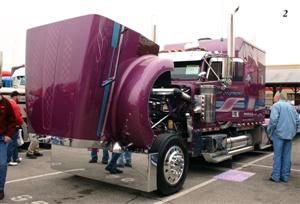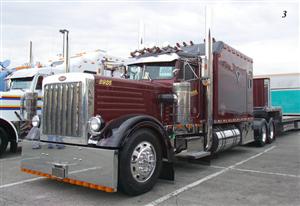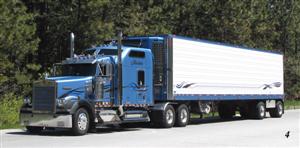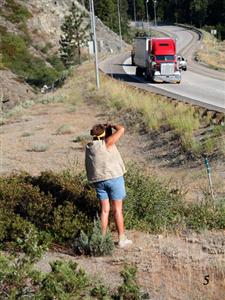OCTOBER 2006 TRUCKER TALK
THE BENEFITS
OF A SHINY TRUCK
By Writers and Owner
Operators Rod & Kim Grimm
I recently read an article (in another magazine) that criticized putting chrome on your truck. Rod and I were offended at the accusation that we were wasting money buying chrome for our rig. Many of our friends, who had read the same article, disagreed with the author’s opinion as well, in regards to the benefits of having chrome on your truck. With that said, let’s discuss some of the reasons why chrome is not a bad thing.
There really isn’t so much made out of steel and chrome plated anymore, and that is a good thing. We’ve bought lots of chrome mud flap weights, only to have them chip and rust in a relatively short period of time. Most “chrome” parts today are really made out of stainless steel. Stainless is known to be more costly, but it’s well worth the difference in price when it comes to cleaning and longevity.
Rod and I have had a lot of our aluminum parts wrapped in stainless to eliminate the need for buffing. When you take care of your aluminum and add up the cost of buffing and the time you spend getting it done, that “easy” shine that comes with stainless can pay for itself fairly fast. It’s really nice to pull in to a truck wash in the middle of winter and pull out it looking like you just had everything buffed and polished. And with all the chemicals they use on the roads these days, stainless is much tougher than aluminum or chrome plated steel.
 I’ve
heard all the comments about our truck like, “All that chrome doesn’t
make you any more money,” and “All that chrome doesn’t make you get better
fuel mileage.” No, maybe it doesn’t “make” us more money, but it is a
tax deduction. Do you enjoy paying the IRS more of your money? Your driving
habits are what determine your fuel mileage, so a smooth piece of stainless
is probably not going to create a lot of extra drag on your rig.
I’ve
heard all the comments about our truck like, “All that chrome doesn’t
make you any more money,” and “All that chrome doesn’t make you get better
fuel mileage.” No, maybe it doesn’t “make” us more money, but it is a
tax deduction. Do you enjoy paying the IRS more of your money? Your driving
habits are what determine your fuel mileage, so a smooth piece of stainless
is probably not going to create a lot of extra drag on your rig.
We have several customers that we deliver to and pick up from that know us and our truck. Why? Because it looks good and stands out above most of the trucks they see. Not too long ago, while picking up at a new customer, they were pretty impressed when we pulled in (and very helpful). We needed a couple of pallets pulled out and their product put in front of them so I asked if they could do it for us. They didn’t have a problem doing it for us at all. When I told them how old our truck was (eight years) and how many miles it has on it, they couldn’t believe it. This week it will turn over 1,800,000 miles and it makes us feel pretty good when it’s mistaken for a new truck (photo 4). This truck is tried and true and we know how it’s been maintained. We often get asked, “When are you going to get a new truck?” We have no plans for a new truck.
Another question we hear is, “How long will your truck last?” I like to point out that Leonard & Charlene Testermann have a 1983 Pete 359 with over 3.5 million miles on it and it still looks like new (photo 3). Darian Stephens’ 1995 Freightliner is another “new-looking” truck, and it has almost 1.6 million miles on it (photo 2). Buy a new truck? No thanks. “But what about depreciation,” you might ask? We spend that money on maintenance and not a payment – both are tax deductible. You still have to maintain a new truck and let’s face it, the warranty doesn’t last forever. When our old Kenworth was new, the warranty expired in five months, and the engine warranty only lasted about two years. Whatever happens after that is your responsibility – and you’re still making the truck payment.
 Another
“shiny” part of our truck is the lights. Yes, I have an opinion on those
too. The new rule about the position of marker lights on the back of your
trailer (and the fact that they have to be in groups of three) is ridiculous!
If you mistake a trailer with a full row of lights across the top on the
back for something other than a trailer, maybe you shouldn’t be driving
at night. That grouping of three rule was done when all we had were two-lane
roads and because cars back then didn’t always have a taillight on each
side like they do today (that tells you how old this law is). Back then,
it was probably a very good idea. But today, the traffic has increased
just a little bit, the roads have gotten a little better, and, let’s face
it, we all want to be safe. I don’t understand how an underlit truck and
trailer is safer at night than one with extra lights.
Another
“shiny” part of our truck is the lights. Yes, I have an opinion on those
too. The new rule about the position of marker lights on the back of your
trailer (and the fact that they have to be in groups of three) is ridiculous!
If you mistake a trailer with a full row of lights across the top on the
back for something other than a trailer, maybe you shouldn’t be driving
at night. That grouping of three rule was done when all we had were two-lane
roads and because cars back then didn’t always have a taillight on each
side like they do today (that tells you how old this law is). Back then,
it was probably a very good idea. But today, the traffic has increased
just a little bit, the roads have gotten a little better, and, let’s face
it, we all want to be safe. I don’t understand how an underlit truck and
trailer is safer at night than one with extra lights.
We used to pull 53’ company trailers that only had two lights on the side – one in the center of the trailer and one at the back – one light on each front corner at the top, and three lights between the taillights on the back. There were no lights on the sides on the top rail of the trailer. Looking back, that doesn’t seem very safe. Some might think that the reflective tape required by law along the sides of the trailer should make it safe at night, but the tape really doesn’t work very well in conditions like fog and snow. In those conditions, you have a better chance of being seen with a lot of lights on.
Now to be fair, I will say that some drivers do get carried away with the amount and arrangement of their lights, or they think a super bright bumper is cool. Obviously, they don’t have to back in next to that really bright bumper shining in their mirrors. That’s not cool, it’s inconsiderate. If you have a brightly-lit bumper, put it on a separate switch and shut it off when you park. The hood you save from being hit may be your own.
 If
you were going to have a truck haul your freight and you had to choose
between one that was shiny and well-maintained and one that looked terrible
and in need of work, which would you choose to put your valuable product
in? You don’t have to have all that shine to be dependable, but it doesn’t
hurt. Customers look at you and your equipment and often make a quick
determination as to how you will take care of their freight. If you take
care of your equipment (and yourself), chances are you’ll take care of
their freight as well.
If
you were going to have a truck haul your freight and you had to choose
between one that was shiny and well-maintained and one that looked terrible
and in need of work, which would you choose to put your valuable product
in? You don’t have to have all that shine to be dependable, but it doesn’t
hurt. Customers look at you and your equipment and often make a quick
determination as to how you will take care of their freight. If you take
care of your equipment (and yourself), chances are you’ll take care of
their freight as well.
Talking about all that shines, Erik and Dan (photo 1) of 10-4 do a great job of shooting shiny trucks for the cover (and centerfold) of the magazine. They find backgrounds that compliment the truck they’ve picked, get up early (hoping for the perfect light), lay down on the ground, get up on a ladder, or ride a pallet up in the air while it’s on the forks of a forklift (hang on Dan), all for the perfect shot. We are very proud to have been featured on the cover of 10-4 back in November of 2005 – It’s hard to believe it’s been a year since our photo shoot in San Francisco on 10-4 Day (October 4th)! Yes, having a lot of “shine” might help get your truck in a magazine too, and that’s always fun.
Our good friend Bette Garber is the queen of shooting big trucks. We have been witness to what she does to get the perfect shot. You should be getting the “picture” that all those beautiful pictures don’t just happen – they take planning, creativity and a little bit of luck. Bette doesn’t only shoot the show trucks; she goes out on the road to get stock photos as well (photo 5). She’s rode with us several times, and I can tell you she walks the walk of the trucker. If we have to run hard, she does what she can to not hold us up and still get great pics. She even went as far as to get her CDL – not to drive for a living, but to better understand what we do. Our mutual friend Dave Sweetman recently paid her the highest compliment saying, “You’re just an old road dog like the rest of us.”
 Bette
has written three books featuring those shiny big trucks and they’ve been
an overwhelming success (her first two books are paperbacks and her third
one is a very nice hardcover book). They are available at several chrome
shops, truck stops and websites (amazon.com, walmart.com and motorbooks.com),
as well as “brick and mortar” chain stores like Barnes & Noble and
Borders. Wherever you find them, they all make great Christmas presents
for the big truck lover, so get one or two today (December will be here
before you know it).
Bette
has written three books featuring those shiny big trucks and they’ve been
an overwhelming success (her first two books are paperbacks and her third
one is a very nice hardcover book). They are available at several chrome
shops, truck stops and websites (amazon.com, walmart.com and motorbooks.com),
as well as “brick and mortar” chain stores like Barnes & Noble and
Borders. Wherever you find them, they all make great Christmas presents
for the big truck lover, so get one or two today (December will be here
before you know it).
I may have strayed off the point a bit in this article, but the facts remain the same. A shiny truck is a safer truck that helps give the industry a better image and gives your customers confidence that their freight will be well taken care of. Spending money on chrome is tax deductible, so why not buy some? Your local chrome shop will thank you for the business, too. So instead of spending your money on a new truck with a big payment every month, spend it on keeping your old truck running and looking good. It’s worked for us. Be safe and keep it shiny!
Copyright
© 2006 10-4 Magazine and Tenfourmagazine.com
PO Box 7377 Huntington Beach, CA, 92615 tel. (714) 378-9990 fax
(714) 962-8506

